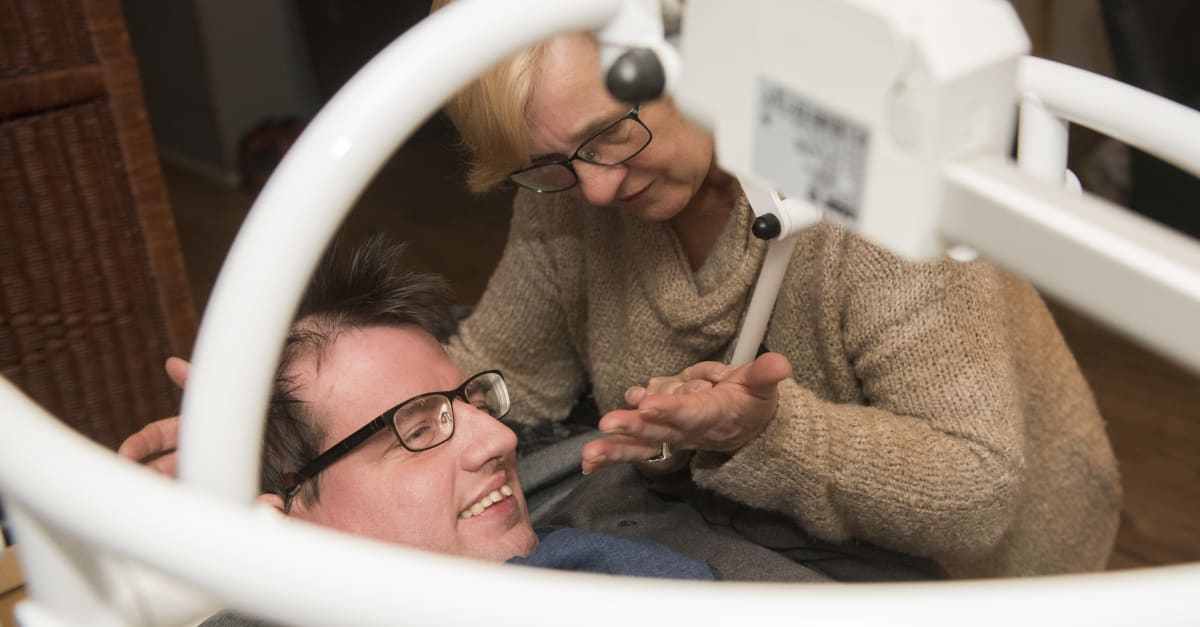
Science and practice come together in the EMB Growth Guide
First, in terms of who is involved: what do young people with (very) severe multiple disabilities gain from the EMB Growth Guide? Leutwyler: These young people and their families in particular need a lot of support as they grow into adulthood, because that’s very different from other kids who are becoming independent and leaving home. We know from the literature that experiencing more influence and active participation is possible for this target group. As a young EMB, this means not just watching, but also being tasked with looking after them or setting the table. Or not only do you get moved during exercise, but you also get to actively move yourself.’
A tangible and practical tool
Although the EMB Growth Guide is still in full development, the conversation tool can already count on enthusiastic responses in practice. At the end of the year, Nicole Leutwiler hopes to obtain a doctorate for her use of the Developmental Guide, a Canadian-origin tool that is also used in the Netherlands to treat cerebral palsy and epilepsy. However, according to the researcher, there is a significant difference from the original tool: “Our modified growth guide is more realistic as a discussion tool for parents and healthcare professionals.” We bring life to life areas such as health, leisure and daytime activities using concrete examples of two young people, Nour and Zaid, and provide practical descriptions with examples. Parents and carers can discuss this.
The researcher explains how they succeeded. “We started with a preliminary study and literature review, like an expert meeting in which we brainstormed with experts and parents to see what they found helpful. As researchers, healthcare professionals, and parents, you really complement each other, even if it’s sometimes conflicting. But This also has added value, although it is useful to have a translator who can bring the knowledge together well. As a researcher, I noticed that this objective view has already produced new knowledge and a new product that we can use in different contexts in healthcare, education and day care.
Follow up research
What also distinguishes this research is that Nicole Leutwiler speaks the language of different worlds. Not only is she a PhD candidate, she is also a healthcare professional (as a pediatric physical therapist and orthotist) and an expert by experience. As a mother of a young daughter with severe multiple disabilities: “This research touches on my personal mission, because I believe there are still so many opportunities for these young people. I really enjoy practical work, but I also have a strong curiosity and wanted to make a difference for this target group on a broad scale.” Wider.
These are the final stages for a doctoral candidate. After earning her doctorate, she hopes to pursue research in an academic workshop. “We would very much like to actively engage young people working in EMBs in research, as this is still difficult. We want to provide the Growth Evidence to more healthcare organizations to further validate the tool. The EMB Growth Evidence is certainly not copy and paste Other evidence of growth.
In this video Nicole tells more about the project.
Tips for healthcare professionals
Does Nicole have any tips for healthcare professionals who want to start researching on their own? “Do it!” she says immediately. “Contributions to research can be made in different ways and in different roles. The so-called participation matrix shows these different roles; you can participate in research or, like me, do four years of doctoral research and everything in between. Look at all aspects of research, and see what appeals to you And what role do you fit in. This also applies to experts by experience: even my husband, who has nothing to do with research, has participated in my research several times because it suits our situation and for healthcare professionals: this way you can have an impact on a broader scale than you currently receive Therapy then it could be interesting!”
EMB Academy Groningen Workshop: Tips for Researchers
- As a researcher, be curious about practice, because this is where the most important questions lie.
- Go take a look, take a tour and feed.
- Make use of experiential knowledge: Don’t forget to involve parents, young people and professionals in the research. This often only happens at a later stage, as a responder. This is a missed opportunity. Involve them in the research question, because the research will be more closely aligned with practice.

“Travel enthusiast. Alcohol lover. Friendly entrepreneur. Coffeeaholic. Award-winning writer.”
